No singing bowl is complete without a beautiful mallet or striker. But what kind is best for your singing bowl? In this post, we describe the kinds of singing bowl mallets and strikers, explain which kinds work best for certain bowls, and reveal the different methods of using your mallet or striker. Let's get started!
Introduction
After choosing your singing bowl, it may seem like a daunting, overwhelming task to choose the right singing bowl mallet, striker, puja stick, or gonger tool. However, it doesn’t have to be! Understanding the different types and uses of singing bowls and mallets will help you choose an appropriate singing bowl mallet. Here’s everything you need to know about singing bowl mallets.
In this article:
- What are singing bowls?
- What are the different uses of singing bowls?
- What are singing bowl mallets?
- Types of singing bowl mallets
- Which mallets work best for certain bowls
- Different methods for using your singing bowl mallet
Introduction
A quick Google search of “singing bowl mallets” will render over 1 million search results. However, most of these links are to mallets for sale, with little explanation of their use or how to get the best results. Few of these resources outline the ways that different sounds can be produced by different tools and techniques.
Singing bowls can have two, three, or even four main tones, in addition to more subtle ones. Bringing out these different tones is completely dependent on the type of mallet being used.
Learning how to make your singing bowl sing does not have to be difficult when you have the right information. Consider this article a comprehensive guide on choosing the right singing bowl mallet for your purposes, your bowl, and yourself.
What Are Singing Bowls?
Singing bowls, also referred to as Tibetan singing bowls or Himalyan singing bowls, are ancient bowls that produce sounds and vibrations when struck by a mallet. These vibrations are frequencies that we can hear and feel in our bodies and energy fields. Many original singing bowls can be traced back to Tibetan Buddhist areas such as Tibet and Nepal. Even modern singing bowls are often manufactured in the Nepalese capital, Kathmandu.
 Photo Credit: Ohm Therapeutics
Photo Credit: Ohm Therapeutics
Singing bowls are generally made from an alloy of various metals which include copper, silver, iron, tin, lead and even gold. More recently, pure crystal singing bowls have become more popular. In addition to being made of a variety of materials, there are almost 50 different types of antique Himalayan singing bowls, though their functions are all similar. Naga, Manu/Mudra, Manipuri, Remuna, Jambati, Utabati, Thadobati, and Lingan are the most basic, widely recognized types of singing bowls.
Unfortunately, much of the history of singing bowls remains unknown due to the Chinese invasion of Tibet in the 1950s. The oral traditions that remain regarding singing bowls place their existence back to the time of the historical Buddha Shakyamuni (560 - 480 BCE). The singing bowls were brought from India to Tibet, along with the teachings of the Buddha. During this time and for hundreds of years after, singing bowls were used in a number of ways. Some scholars say that they were used as begging bowls, bowls to eat from, as well as storage for grain. However, their main uses were as a sacrificial bowl or musical instrument within Buddhist monasteries and temples.
What Are The Different Uses of Singing Bowls?
Singing bowls are primarily used during meditation practice by Buddhist practitioners in their homes, monasteries, and temples. Tibetan Buddhist spiritual leaders (rinpoches) and monks also use singing bowls to perform other activities such as chanting, marking the passage of time, or signaling a change in activity. Furthermore, Japanese and Vietnammese Buddhists have been known to use singing bowls in traditional funeral rites and to worship their ancestors.
When used as a tool for meditation or grounding, singing bowls provide the user with a harmonic aura that helps them concentrate with peace and intuition. Buddhists use singing bowls in order to bring themselves closer to the ultimate peace and calm by way of the sounds produced by the bowls. Those that meditate with a singing bowl can experience deep feelings of connection and release, which ultimately brings about a strong sense of wellness.

Source: DharmaShop
The connection between singing bowls and essential wellness has also lead the singing bowl’s migration to places outside of Buddhist spaces since the 1980s. For example, many sound healers and sound healing therapists have found that singing bowls have many medicinal values in their healing practices. Physical healing benefits include:
- Improved immunity
- Improved blood pressure
- Improved circulation
- Increased mental and emotional awareness
- Reduced stress and anxiety
- Alleviation of pain and depression
- Promotion of an overall state of happiness and wellness
When used in pain management, Shatki Gray says the bowl’s vibrations often address the ancillary effects of pain such as stress, muscle tension, anger, frustration, and hopelessness, rather than the pain itself. For this reason, although there is little scientific support for the healing effects of singing bowls, medical professionals still like to incorporate singing bowls into their treatments. Illnesses and diseases often create the need for stress management techniques, like meditation, deep breathing, and guided imagery, which is where a singing bowl might be used.
In addition to traditional healing and therapeutic spaces, singing bowls have also gained popularity within the meditation and yoga communities, classrooms, as well as in chakra healing. Various practitioners have written about the chakra healing capabilities that singing bowls possess. Singing bowls have the ability to realign the chakra of the user. According to Jevon Dängeli, an Authentic Self Empowerment (ASE) Facilitator and Trainer, singing bowls naturally cause chakras to self-correct. The vibrations produced create sound waves with frequencies that bring unbalanced chakras back to normal functioning.
What Are Singing Bowl Mallets?
In order to create the sounds and vibrations singing bowls are famously known for, a mallet or striker must be used. The friction of the mallet against the bowl is what produces the sound-making vibrations. The mallets and strikers are among the most important part in producing the relaxing sounds for meditation, healing, and spiritual practices. While singing bowls can be considered “tools of discovery”, they are rather ineffective without tools such as mallets, strikers, gongers, and puja sticks. In fact, singing bowls can sound completely different depending on the material they are struck with.
It is very important to find the right striker to play with since singing bowls might play extremely well with one mallet and then not sing at all with another. Often times when purchasing a singing bowl an appropriate mallet will be included. However, if your singing bowl does not come with a mallet or you feel unsatisfied with your current mallet, it is important to understand the different types and uses of the different singing bowl mallets in order to make your selection.
Throughout the years, the tools used to play singing bowls have evolved and expanded. Historically, plain wooden dowels were used. However, as we will discuss later on, wooden sticks can create harsh, high-pitched sounds that drown out the fundamental tone. The varied success of wooden sticks led to the use of padded mallets, which create lower pitched tones and a better sound when struck on the metal. Today, a wide array of singing bowls can be found at an equally wide array of price points. Strikers range from as low as $10 USD to over $100 USD, however, the average price rests at about $35 USD.
Types
Singing bowl mallets come in different sizes and are made from different materials. Different sizes, handles, and materials can all lead to different sounds being produced by the singing bowl. Luckily, many of the following mallets are dual-ended, allowing both ends to be used to produce two different results. We will discuss the main types of mallets and then which mallets work best with which singing bowls.
Wool Padded Mallet
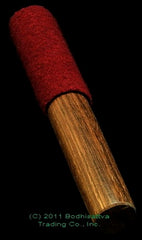
Wool padded mallets are designed to bring all of the bowls’ frequencies up at an equal volume so that certain tones are not louder than others, drowning out more subtle, still pleasant tones.
Suede Mallet
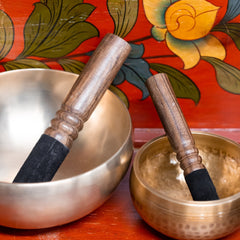
Suede mallets began to be used in the late 1990s and are mostly used for the rimming method of playing a singing bowl. Generally they are made of a harder wood and wrapped with suede, which produces less-harsh, more ethereal sounds.
Fat Boy
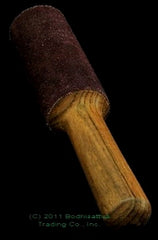
Fat Boy is a mallet whose width measures between 40 and 60mm, should be used with larger singing bowls as there is a greater surface area of suede.
Xcelite Mallet
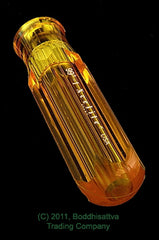
The Xcelite mallet might look like an average, household item and that’s largely because it is--it’s a modified screwdriver handle. The Xcelite mallet is a good option if you are planning on recording or playing your singing bowl live into a microphone.
Gong Mallet
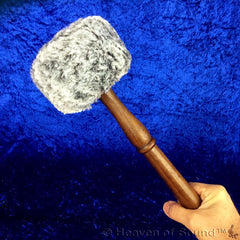
Gong mallets are used for tall, larger sized singing bowls. These mallets can be felt, wool, or rubber padded. Gong mallets emphasize deeper tones but can help create softer gong-like sounds.
Mallets from Ludwig Drums
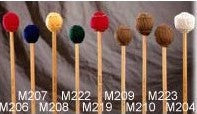
Mallets produced by Ludwig Drums are characterized by small heads and long handles. These characteristics allow the user good control while playing. The oval shaped heads allow users to play the bowl at different angles. There are several types of mallets from Ludwig Drums that can be used with your singing bowl.
- Musser small cord mallets has one inch heads that can be soft, medium, or hard. They have long handles and work well with small singing bowls.
- Musser small fluffy yarn mallets have a larger head and are best for medium sized and larger sized singing bowls. Similar to the small cord mallet, the head ranges from soft to hard. Softer heads produce lower tones, while harder mallets produce higher tones.
-
Musser large mallets are best for large singing bowls and are comparable to Nepali felt mallets.
Nepali Felt Mallets

Nepali Felt mallets vary in shape, size, and handle length. They are most commonly used with medium or larger bowls like the Jambati singing bowls and Thadobati singing bowls. They also go well with taller, deeper bowls. Nepali Felt mallets are known for producing good rhythms and loud sounds, but are not suitable for rimming. They are also known for being made out of a harder wood, which can be bad for beginners as harder sticks more easily bounce off the singing bowl causing a squeal sound.
Puja Sticks

Puja sticks are the least popular tool to use when playing singing bowls. Made of wood, they are covered almost completely in suede, which helps them achieve a purer sound when rimming. When used as a striker, a deeper, more resonant tone will often be achieved.
Crystal Singing Bowl Mallets
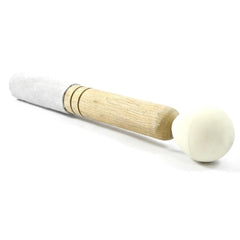
As crystal singing bowls have become more popular, the creation of new tools to play them increased. Crystal singing bowls are often played with dual-ended mallets. One end, most often, is made of pure crystal, like the singing bowl itself. The other end could be suede but is more likely to be silicone or rubber. Silicone and rubber mallets reduce the sound of friction when playing crystal singing bowls. Silicone mallets have a smoother sound and do not wear down and shred as quickly as other materials. Crystal singing bowls can also be played with solid, clear quartz, which will make for a heavy striker.
Which Mallets Work Best for Certain Bowls
While the easiest way to select a striker is to go to a store that sells singing bowls in person, we realize that you may not have access to a store that meets your needs. If you are unable to test different strikers with your singing bowl in person, there are several tips to keep in mind while shopping online in order to find a mallet which works best for your bowl.
A general rule to keep in mind is that the size of the mallet should be proportionate to the size of the bowl. This pairing creates the most optimal circumstances for creating relaxing and soothing sounds. Another rule to keep in mind is that the larger the bowl, the softer the mallet. Lastly, though it might seem self-explanatory, be sure to find a mallet that fits comfortably in your hand. You want to avoid mallets which feel awkward or uncomfortable, as they can be hard to handle if you plan on playing your singing bowl for an extended period of time.
Larger bowls, which produce deep octaves, are suitable for meditative purposes. Medium sized bowls are suitable for grounding purposes and smaller bowls, with their higher tones, are suitable for physical healing. Each of those bowls require the use of certain mallets.
Small Sized Singing Bowls
Small, light bowls need lighter mallets. If the mallet is too large, it can push the singing bowl around. A stiffer wooden handle, like birch, is also best for small singing bowls. Manipuri singing bowls are often the smallest of the basic kinds of singing bowls. Manipuri singing bowls, for example, when lightly tapped with a very hard mallet give out the most sound. Furthermore, when small sized bowls are struck by hard, suede mallets, the sound will often come off as deeper and louder than a wool padded mallet. Musser small cord mallets work well with small sized singing bowls.
Medium Sized Singing Bowls
Mallets measuring about 30 mm thick will produce a balanced tone when it strikes a medium sized singing bowl. Nepali mallets work best for medium bowls, such as Jambati or Thadobati singing bowls. However, suede mallets and musser small fluffy yarn mallets can also be used.
Large Sized Singing Bowls
Large sized singing bowls work best with mallets with flexible, wooden handles, like rattan. Larger, thicker mallets, such as the Fat Boy mentioned earlier, should be used with large sized singing bowls. Using a larger mallet with a large singing bowl should bring out higher octave fundamental tones. Musser small fluffy yarn mallets can be used with large sized singing bowls, though Musser large mallets are best. Large bowls also require mallets with heavy heads that are not too hard nor too soft. It is recommended that the head be padded or made from felt. Big mallets will bring out powerful sounds from larged sized singing bowls.
Different Methods For Using Your Singing Bowl Mallet
Different tones can be produced by different mallets as well as by different techniques of playing a singing bowl. The striking method is most often used by beginners and to signal the passage of time or changing of activities in yoga, classrooms, monasteries and temples. To use this method, simply hit the bowl in the correct place to hear a loud, lasting tone.
The rimming method is slightly more complicated but can be picked up with ease and practice. Rimming involves circling the bowl with your mallet or other tool. Think of it like stirring a pot of soup. Lastly, the “wah-wah”, the most advanced of these methods, allows users to create sound and feel vibrations within their mouth.
Striking
A wool padded mallet can be used for striking. In order to use the wool padded mallet for striking, the user must strike the singing bowl on its mid-exterior wall or its interior upper wall. Striking a singing bowl with a wool padded mallet will create a rich fundamental tone.
A suede mallet can be used for striking, however, the strike will not be as soft as a strike with a wool padded mallet.
A gong mallet can be used for striking when working with a large, tall singing bowl. It is suggested that gong mallets be used with bowls that rest on a cushion or on the body.
Rimming
A wool padded mallet can be used for rimming. In order to use the wool padded mallet for rimming, the user must place the mallet in their dominant hand, grasping the center of the mallet. The wooden part of the mallet should face the bowl while the wool-covered part should face upwards. Rub the mallet against the outside edge of the lip of the bowl. After making four to five revolutions, the female overtone should build. Once the female overtone is present and clear, reduce your speed in order to create a more even voice.
As previously stated, suede mallets are most commonly used as rimming tools. When used for rimming, suede mallets create a female overtone faster as well as create less friction noise than wooden tools. Additionally, suede mallets can be used to isolate the fundamental. In order to do so, the bowl’s outer wall must be rubbed with the suede end of the mallet with lighter pressure and a faster speed. This method requires a deeper level of awareness, breath, and concentration which might be more difficult for beginners.
Xcelite mallets can be used to rim singing bowls, though they do require extra practice.
Wah-Wah
The wah-wah method is the most advanced of the methods listed here and is relatively rare to create. A singing bowl with hand wah-wah capabilities is needed to perform this method. Often, a “sweet spot” needs to be found through trial and error. With this method, the technique is far more important than the mallet type. Any covered mallet, whether it's felt, wool or suede will work with this method. After striking the bowl with the covered end of the mallet, raise the singing bowl to your mouth, purse your lips and vocalize the sound ‘wah.’ You will be able to feel the vibration in your mouth.
Conclusion
With many types of singing bowls and almost as many types of mallets, selecting the right mallet can be difficult. Hopefully, this guide has given you the information and tips needed to make an appropriate selection. If you find that a mallet isn’t working, use it as an opportunity to experience several different mallets. It can be enjoyable to play with your singing bowl and discover the mallet that makes the best sound with your singing bowl. Be patient with the process and yourself as it does take time to play the bowl with ease.
Check out our other blog post for a few tips on how to break in a new mallet. First, play the bowl for about five minutes. As you use your mallet, the material will begin to develop ‘micro-grooves.’ These grooves help grip the rim of the bowl better. Over time, the grooves will help improve the sound of the singing bowl.
We invite you to get your own Tibetan singing bowl or crystal singing bowl today! Good luck and happy playing!
Did You Enjoy This Article?
Thank you for reading! If you enjoyed this article, you might also like the following articles: Tongue Drums: Complete Guide and How to Choose a Singing Bowl: Complete Guide

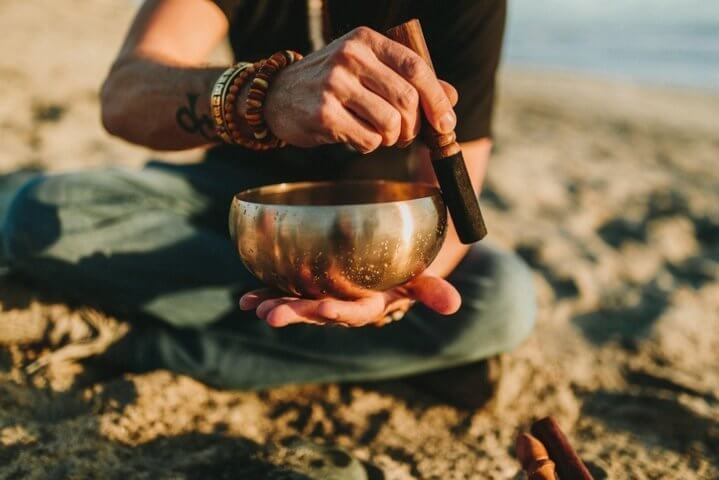
14 comments
Nov 23, 2021 • Posted by Shanti Bowl
Hi Dale, thanks for your question! We would suggest using a soft rubber mallet, as these works best for glass and crystal. Make sure to strike gently, as glass and crystal can be very fragile. We hope that helps and good luck!
Nov 23, 2021 • Posted by Dale Wolch
I have a collection of hand cut lead crystal bowls and vases. Some of them give it a lovely sound when I ping them with my finger. I was looking online for some sort of a mallet to use on them to avoid finger soreness. I discovered your site and thus have discovered singing bowls. What mallet would you recommend for use in cut crystal vases and bowls? I wish to develop striking skills on my own crystal before I graduate to “proper” crystal singing bowls. Thanks. Dale
May 24, 2021 • Posted by Shanti Bowl
Hi Michael, thanks for your question! We would recommend using a wood or padded mallet for best results with a metal singing bowl. The rubber mallets used with crystals bowls usually do not glide very smoothly over a metal bowl, and that can affect sound quality. We hope that helps!
May 24, 2021 • Posted by MICHAEL A JOHNSON
Can the rubber mallets that are used with crystal bowls be used for rimming traditional Tibetan metal bowls?
Apr 15, 2021 • Posted by Shanti Bowl
Hi Aly, thanks for your message! Yes, it sounds like the mallet you got from your apothecary has issues. Have you thought about going back to them and asking them to replace it? Or, if you are looking for a great quality bowl and mallet, check out what we have on offer! Just click the “shop” button above to see our selection!
Apr 15, 2021 • Posted by Aly
I bought a small singing bowl from an apothecary and i think the mallet is broken or something
Wish i could send a pic to be sureIt looks like it was supposed to be a crystal singing bowl mallet but there are two holes on each side of it like there was supposed to be something attached at each end
Feb 24, 2021 • Posted by Shanti Bowl
Hi Dave, thanks very much for your question! For crystal bowls, we recommend soft padded mallets. Click the “shop” button on the menu at the top of the screen and check out the crystal singing bowls we have for sale. You will see the kinds of mallets they come with. In our experience, these mallets are ideal for crystal singing bowls because they are firm enough to create a great sound but soft enough that they will not damage the bowl.
Feb 24, 2021 • Posted by Dave
Hi
So I need to choose a suitable mallet for a large crystal bowl. Is there a type or range that you recommend?
Thanks
Dave
Apr 20, 2020 • Posted by Shanti Bowl
Hi Karin, thanks for your comment! We recommend not using the same section of suede on your mallet every time with your singing bowl so as to more evenly distribute the wear over time. Try moving up or down and an inch and circle the bowl with that section of the mallet instead. If the suede completely wears down you can always remove it and replace it.
Apr 20, 2020 • Posted by Karin Johnson
The suede on my mallet seems to have become dried out & now makes a scraping sound on my large crystal bowl. Is there a way I can condition the suede to make it “moister” & softer again? Is there a proper care of the mallet? Thank you!
Leave a comment